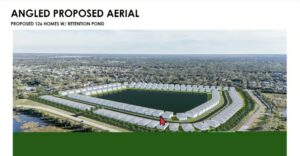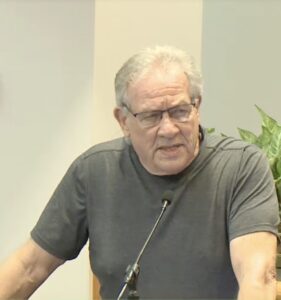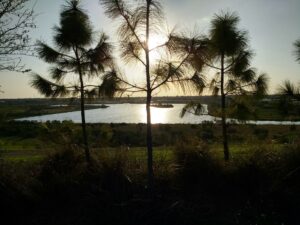The Sarasota County Commission unanimously rejected D.R. Horton’s proposal. Now, the Texas-based homebuilders is asking for an ‘alternative solution’.
By Mason Chambless
Original Air Date: August 13, 2025
Host: In a rare and surprising move earlier this year, the five Sarasota County commissioners voted unanimously to deny a national homebuilder a rezone to build a new subdivision on pasture land. Now, half a year later, D.R. Horton is back, bringing more lawyers. Mason Chambless reports.
Mason Chambless: In February, the Sarasota County Commission blocked a D.R. Horton proposal to build 126 homes next to a bird sanctuary over concerns for the environmental and traffic impact. Now, the developer made a legal move to push for approval of the project.

Render of the proposed 126 homes and retention pond on the Smith Properties land
Texas-based D.R. Horton, which operates in 36 states, has requested a hearing with special magistrate Mark P. Barnebey to explore the possibilities of “finding an alternative solution” to the decision made in February. Working outside the courts, a special magistrate helps to seek resolution between the county and other parties regarding legal and administrative issues. A notice of hearing was sent out to individuals who submitted speaker cards at the county commission meeting in February.
The company’s project triggered pushback from neighbors, environmentalists, and even a county commission that had been solidly in the camp of developers. This was mainly because of the location—the 500 acres of cattle grazing land that was formerly used to grow vegetables is bordered by Celery Fields on two sides. Celery Fields is the name of a 300 acre property that was purchased by the City of Sarasota in the 1990s and transformed into a stormwater management facility. The property flooded during last year’s hurricane season.
SCANning Sarasota PLANning is a watch group that has been one of the most vocal opponents to the plan. Tom Matrullo, one of the initiators of the group, listed his worries about the project. Full disclosure: Matrullo is a board member of WSLR.

Tom Matrullo
Tom Matrullo: It was manifold issues ranging from the quality of the soil—which could definitely have a lot of arsenic in it—that they want to build on to the location right next to the most valued and important birding area where the birds really do flock to nest and to feed. To the question of what the impact of a 126-home development would have upon an area that is supposed to be very peaceful to allow birds to do their thing without being molested by noise, light, fumes, traffic, the Celery Fields has become an area of public interest in Sarasota County, and as such, the public wants it to be preserved and protected. The county has had a policy of not turning on the street lights along Palmer Boulevard precisely because they’re respecting the needs of the birds to have nighttime peace.
MC: Matrullo stressed that while Celery Fields was originally only intended to be a water management system to control flooding, it has since become so much more.
TM: What benefit that kind of came out of nowhere—no one really expected this—was the habitat that developed for birds and other creatures. It’s not just birds there; you’ve got all kinds of animals in there. With that value came tourism and came the fact that people use the Celery Fields to exercise, to train.

Celery Fields
There’s all kinds of uses there—walk their dogs, et cetera. But that value of the Celery Fields is a natural asset now. In a sense, the birds created that value.
MC: In the initial proposal for the project, D.R. Horton claimed that they had made efforts to reduce the environmental impact of the development. Ultimately, those measures weren’t enough to alleviate fears.
I asked Matrullo if there is anything that D.R. Horton could do, environmentally, to make this plan tenable. He said he did not think so. The land is currently zoned for five houses, and putting five houses in the southern part of the land is plausible, he says, but not the 126 D.R. Horton wants to build. Beyond his concerns about the local environment, Matrullo says that this project stands for the elephant in the room: Overdevelopment in the entire region. He brings up Jon Thaxton, who is a member of the Sarasota County Planning Commission and a bird enthusiast.
TM: We’re at a point now where, as Jon Thaxton has repeatedly noted, we have homes approved that equal the number of homes already built so that, if we were to build all those homes and then put people in them today, the population of Sarasota County would be over 800,000—probably 850,000. The question is, do our roads support that? Can our natural ecosystem support that? We’ve got plenty of homes already on the drawing boards, already approved. Why do you have to come into a small parcel of land next to one of the most precious natural attractions and valued places in Sarasota and insist you have the right to build 126 homes or even 60 homes?
MC: The Sarasota County Special Magistrate will hold a meeting regarding the development proposal on September 11 at 9 a.m. in the county commission chambers. The meeting will be open to the public.
We reached out to the Sarasota County Commission, and they were unable to make a comment before our deadline.
When we reached out to D.R. Horton, they said that they had no comment to make.
With WSLR News, this is Mason Chambless.
WSLR News aims to keep the local community informed with our 1/2 hour local news show, quarterly newspaper and social media feeds. The local news broadcast airs on Wednesdays and Fridays at 6pm.